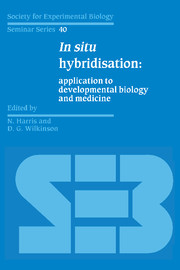Book contents
- Frontmatter
- Contents
- List of contributors
- Preface
- Non-radioisotopic labels for in situ hybridisation histochemistry: a histochemist's view.
- Use of haptenised nucleic acid probes in fluorescent in situ hybridisation
- The use of complementary RNA probes for the identification and localisation of peptide messenger RNA in the diffuse neuroendocrine system
- Contributions of the spatial analysis of gene expression to the study of sea urchin development
- Advantages and limitations of in situ hybridisation as exemplified by the molecular genetic analysis of Drosophila development
- The use of in situ hybridisation to study the localisation of maternal mRNAs during Xenopus oogenesis
- In situ hybridisation in the analysis of genes with potential roles in mouse embryogenesis
- Evolution of algal plastids from eukaryotic endosymbionts
- Localisation of expression of male flower-specific genes from maize by in situ hybridisation
- Tissue preparation techniques for in situ hybridisation studies of storage-protein gene expression during pea seed development
- Investigation of gene expression during plant gametogenesis by in situ hybridisation
- Sexing the human conceptus by in situ hybridisation
- Non-isotopic in situ hybridisation in human pathology
- The demonstration of viral DNA in human tissues by in situ DNA hybridisation
- Index
Localisation of expression of male flower-specific genes from maize by in situ hybridisation
Published online by Cambridge University Press: 04 August 2010
- Frontmatter
- Contents
- List of contributors
- Preface
- Non-radioisotopic labels for in situ hybridisation histochemistry: a histochemist's view.
- Use of haptenised nucleic acid probes in fluorescent in situ hybridisation
- The use of complementary RNA probes for the identification and localisation of peptide messenger RNA in the diffuse neuroendocrine system
- Contributions of the spatial analysis of gene expression to the study of sea urchin development
- Advantages and limitations of in situ hybridisation as exemplified by the molecular genetic analysis of Drosophila development
- The use of in situ hybridisation to study the localisation of maternal mRNAs during Xenopus oogenesis
- In situ hybridisation in the analysis of genes with potential roles in mouse embryogenesis
- Evolution of algal plastids from eukaryotic endosymbionts
- Localisation of expression of male flower-specific genes from maize by in situ hybridisation
- Tissue preparation techniques for in situ hybridisation studies of storage-protein gene expression during pea seed development
- Investigation of gene expression during plant gametogenesis by in situ hybridisation
- Sexing the human conceptus by in situ hybridisation
- Non-isotopic in situ hybridisation in human pathology
- The demonstration of viral DNA in human tissues by in situ DNA hybridisation
- Index
Summary
Introduction
Flowering in plants is a complex process involving the co-ordinated expression of many genes essential for the differentiation of specialised tissues. Whilst many of these genes may also be expressed in other tissues during growth of the plant, an important group of essential genes will be developmental- and tissue-specific, expressed only at critical stages and in defined tissues during the flowering process. In tobacco flowers for example, there are approximately 10000 ovary-specific and 11000 anther-specific mRNAs representing 40% and 42% of all diverse mRNAs present in the respective organs (Kamalay & Goldberg, 1980, 1984).
We are interested in genes which are expressed specifically in the male flowers of maize. In this monoecious plant the male flowers are borne in the tassel which terminates the main stem and the female flowers on ear branches which arise from nodes midway on the main stem. We have used differential screening of cDNA libraries made from whole tassels to isolate six male flower-specific (MFS) cDNAs from maize. Differential screening has also been used to clone floral-specific cDNAs from tomato (McCormick et al., 1987; Gasser et al., 1989), tobacco (Goldberg, 1988), pollen-specific cDNAs from maize (Stinson et al, 1987) and style-specific cDNAs from Brassica oleracea (Nasrallah et al., 1985) and Nicotiana alata (Anderson et al., 1985).
Whilst conventional Northern and dot blotting techniques using whole organ RNA preparations can be used to establish the organ specificity of the cDNA clones, it is clear that these techniques do not localise expression to particular tissues within the organ.
- Type
- Chapter
- Information
- In Situ HybridisationApplication to Developmental Biology and Medicine, pp. 157 - 174Publisher: Cambridge University PressPrint publication year: 1990
- 2
- Cited by



